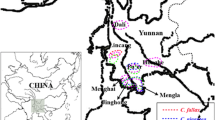Summary
The chromosome complements of 12 taxa in section Arachis were karyotypically and meiotically analysed. In taxa with 2n=20 the arm ratio of the respective pair of chromosomes was taken as an independent quantitative character and statistically analysed by Mahalanobis D2. Two clusters were formed, one represented solely by A. batizocoi and the other consisting of the remaining 11 taxa. This grouping was confirmed by canonical analysis. In the larger group of species, A villosa and A. correntina were closely related karyotypically and on D2 distance, while A. cardenasii forms a distinct subgroup. A. cardenasii lacks the short “A” chromosome recorded in other species of this group, and A. batizocoi is no longer the only species to have a pair of chromosomes with a secondary constriction. The taxa with 2n=40, A. monticola and A. hypogaea, are karyotypically very similar, though there is a difference in the number of chromosome pairs with a secondary constriction. On the basis of karyomorphological affinity, especially in relation to marker chromosomes, A. cardenasii is probably one of the ancestors of the tetraploid species studied.
Similar content being viewed by others
Literature
Babu, C.N. (1955): Cytogenetical investigations on groundnuts. 1: The somatic chromosomes. Indian J. Agric. Sci. 25, 41–46
D'Cruz, R.; Tankasale, M.P. (1961): A note on the chromosome complement of four groundnut varieties. Indian Oilseeds J. 5, 58–59
Ghimpu, V. (1930): Recherches cytologiques sur les genres: Hordeum, Acacia, Medicago, Vitis et Quercus. Arch. d'Anat. Microsc. 26, 136–234
Gregory, W.C.; Gregory, M.P.; Krapovickas, A.; Smith, B.W.; Yarbrough, J.A. (1973): Structure and genetic resources of peanuts. In: Peanuts-Culture and Uses, pp. 47–133. Stillwater Oklahoma (USA): Oklahoma State University
Gregory, W.C.; Gregory, M.P. (1976): Groundnuts. Evolution of Crop Plants (ed. Simmonds, N.W.), pp. 151–154. London: Longmans
Gregory, W.C.; Krapovickas, A.; Gregory, M.P. (1980): Structure, Variation, Evolution, and Classification in Arachis. In: Advances in Legume Science (eds. Summerfield, R.J.; Bunting, A.H.), pp. 469–481. Kew (England): Publ. Royal Botanic Garden
Husted, L. (1933): Cytological studies of the peanut Arachis I. Chromosome number and morphology. Cytologia 5, 109–117
Husted, L. (1936): Cytological studies of the peanut Arachis II. Chromosome number, morphology and behaviour and their application to the origin of cultivated forms. Cytologia 7, 396–423
Kawakami, J. (1930): Chromosome numbers in the Leguminosae. Bot. Mag. 44, 319–328
Krapovickas, A.; Rigoni, U.A. (1951): Estudios citologicos en el genera Arachis. Rev. Invest. Agric. (B. A.) 5, 289–294
Mendes, A.J.T. (1947): Estudios citologicos no genero Arachis. Bragantia 7, 257–267
Murty, B.R.; Arunachalam, V. (1967): Computer programme for some problems in Biometrical Genetics. 1: Use of Mahalonobis D2 in classifactory problems. Indian J. Genet. 27, 60–69
Peter, K.V.; Jain, R.C.; Raju, R.P.; Srivastva, U.K. (1977): Statistics and Computer Programme in Biometric Research. G. B. Pant University of Agriculture and Technology: Exp. Stn. Tech. Bull. 104, 71–75. Pantnagar (India)
Raman, V.S. (1958): Studies in the genus Arachis II. Chromosome numbers of certain species of Arachis. Indian Oilseeds J. 2, 72–73
Raman, V.S. (1959): Studies in the genus Arachis III. A natural interspecific hybrid. Indian Oilseeds J. 3, 226–228
Rao, C.R. (1952): Advanced Statistical Methods in Biometric Research. New York: John Wiley and Sons
Singh, A.K.; Moss, J.P.; Sastri, B.C. (1980): Utilization of wild relatives in genetic improvement of Arachis hypogaea I. Techniques. In: Proc. Seminar on Current Methodological Approaches in Cytogenetics (eds. Roy, R.P.; Sinha, U.). Delhi: Hindasia Publ. (in press)
Singh, R.K.; Chaudhary, B.O. (1977): Biometrical Methods in Quantitative Genetic Analysis. New Delhi: Kalyani Publ.
Smartt, J. (1964): Cross-compatibility relationships between the cultivated peanut Arachis hypogaea L. and other species of the genus Arachis. Ph. D. Thesis, N. C. State University, No. 65, 8968. University Microfilms Int., Ann. Arbor. MI
Smartt, J.; Gregory, W.C.; Gregory, M.P. (1978): The genome of Arachis hypogaea L. Cytogenetic studies of putative genome donors. Euphytica 27, 665–675
Stalker, H.T.; Wynne, J.C. (1979): Cytology of interspecific hybrids in section Arachis of peanuts. Peanut Sci. 6, 110–114
Stebbins, G.L. (1958): Longevity, habitat and release of genetic variability in the higher plants. Cold. Spring Harbor Symp. Quant. Biol. 23, 365–378
Author information
Authors and Affiliations
Additional information
Communicated by J. MacKey
Approved as ICRISAT Journal Article No. 169 and released for publication
Rights and permissions
About this article
Cite this article
Singh, A.K., Moss, J.P. Utilization of wild relatives in genetic improvement of Arachis hypogaea L.. Theoret. Appl. Genetics 61, 305–314 (1982). https://doi.org/10.1007/BF00272846
Received:
Issue Date:
DOI: https://doi.org/10.1007/BF00272846




